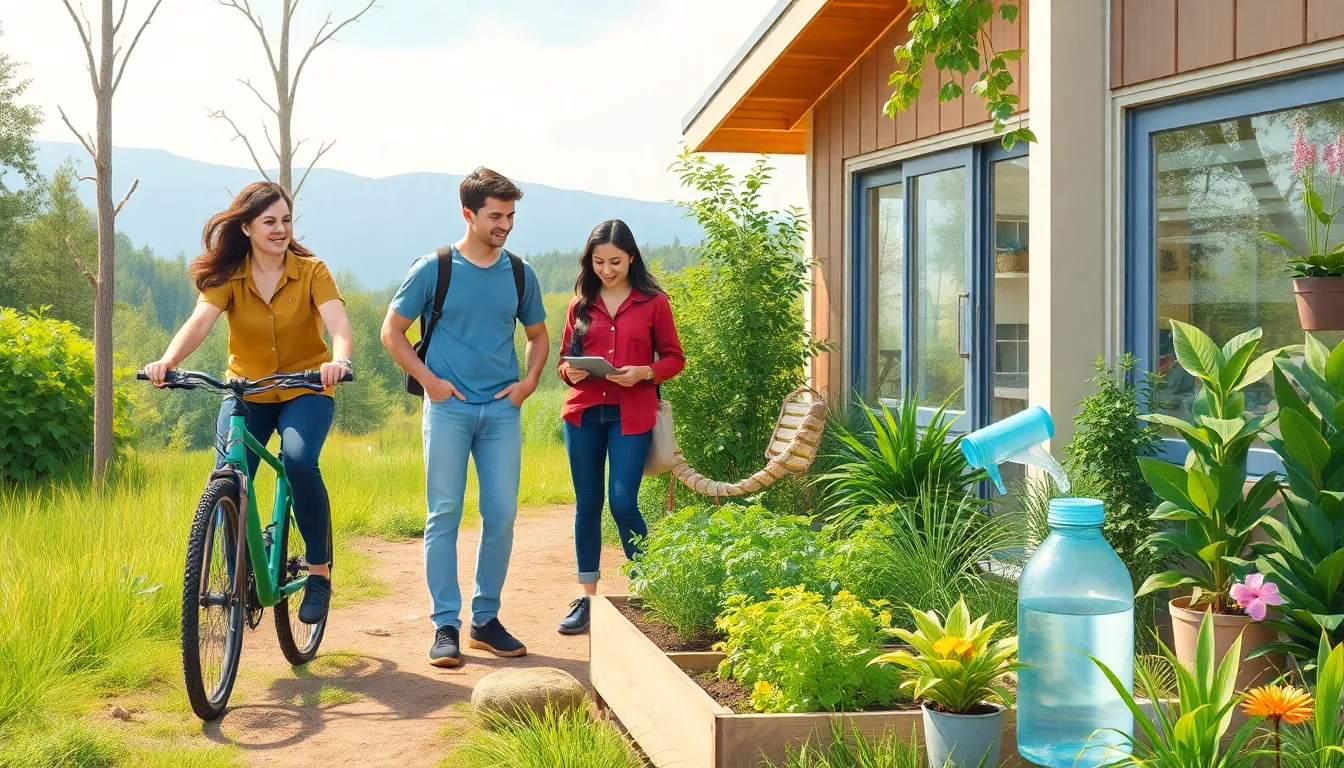In a world where plastic bags seem to multiply like rabbits and the air feels thicker than a bowl of oatmeal, sustainable living solutions are more than just a trendy hashtag. They’re a lifeline for the planet and a way to keep our guilty consciences at bay. Imagine sipping your morning coffee from a reusable mug while feeling like a superhero, saving the Earth one sip at a time.
Sustainable living isn’t just about hugging trees or wearing hemp sandals—it’s about making smart choices that benefit both your wallet and the environment. From energy-efficient appliances to composting like a pro, these solutions can transform everyday habits into eco-friendly practices. So buckle up and get ready to dive into a world where saving the planet is as easy as finding a parking spot at the grocery store.
Sustainable Living Solutions
Sustainable living solutions encompass a variety of practices designed to minimize ecological footprints. These solutions include methods for reducing waste, conserving energy, and using renewable resources. Adopting these approaches contributes significantly to environmental preservation.
Energy-efficient appliances exemplify a key component of sustainable living. These appliances consume less electricity, leading to lower utility bills and reduced greenhouse gas emissions. Utilizing programmable thermostats ensures optimal energy use throughout the day.
Water conservation represents another pillar of sustainable living. Implementing low-flow fixtures and rainwater harvesting systems can significantly reduce water usage. Practicing mindful consumption, such as fixing leaks, further supports this initiative.
Waste reduction practices play a crucial role in minimizing landfill contributions. Composting organic waste transforms it into valuable fertilizer for gardens and plants. Recycling materials like paper, glass, and plastics helps extend their lifecycle and reduces resource extraction.
Choosing sustainable transportation options also significantly impacts guidelines for eco-friendly living. Biking, walking, and using public transit reduce carbon emissions and traffic congestion. Carpooling presents another effective way to minimize individual car use while optimizing resources.
Supporting local and organic food systems contributes to sustainable living solutions as well. Purchasing seasonal produce from farmers’ markets enhances food security while reducing the carbon footprint. Growing food in home gardens promotes self-sufficiency and environmental stewardship.
Ultimately, incorporating these solutions into daily routines fosters a healthier planet and enhances individual well-being. Each small change builds towards a sustainable lifestyle that positively impacts both personal finances and the environment.
Benefits of Sustainable Living Solutions

Sustainable living solutions offer numerous benefits that contribute positively to both the environment and personal finances. Understanding these advantages can motivate individuals to embrace eco-friendly practices.
Environmental Impact
Sustainable living significantly reduces carbon footprints. Through practices like energy conservation and waste reduction, individuals can minimize their contributions to greenhouse gas emissions. Utilizing energy-efficient appliances leads to lower energy consumption, subsequently decreasing pollution levels. Implementing water conservation methods, including rainwater harvesting, ensures responsible water usage. Composting and recycling help divert waste from landfills, thereby preserving natural resources. Adopting sustainable transportation options, such as biking and public transit, lowers greenhouse gas emissions and promotes cleaner air. Collectively, these actions enhance ecosystem health and support biodiversity, fostering a more sustainable planet.
Economic Advantages
Sustainable living solutions provide substantial economic benefits. Investing in energy-efficient appliances results in significant savings on utility bills over time. Individuals who practice waste reduction techniques often find lower trash disposal costs. Supporting local organic food systems not only bolsters local economies, but also reduces transportation costs, leading to fresher produce. Embracing sustainable practices increases property values in eco-conscious neighborhoods, making investments worthwhile. Additionally, reducing resource consumption directly correlates with decreased expenditure, allowing individuals to allocate funds towards other priorities. These financial advantages support a more sustainable lifestyle while encouraging responsible spending.
Practical Tips for Implementing Sustainable Living Solutions
Adopting sustainable living solutions involves practical steps that anyone can take to help the environment and improve personal well-being.
Reducing Energy Consumption
To lower energy consumption, using energy-efficient appliances is crucial. Look for the Energy Star label when purchasing new devices. Switching to LED bulbs provides significant energy savings while offering longer life than traditional bulbs. Adjusting thermostat settings can also create a comfortable environment and reduce energy usage. Insulating homes reduces heating and cooling costs, ensuring efficient energy use. Unplugging idle electronics prevents phantom energy drain, contributing to overall savings. Monitoring daily energy use helps identify areas for improvement.
Sustainable Food Choices
Prioritizing sustainable food choices enhances environmental health. Purchasing local produce supports nearby farmers and reduces transportation emissions. Incorporating more plant-based meals into diets decreases meat-related carbon footprints. Choosing organic foods minimizes chemical usage and promotes biodiversity. Reducing food waste by planning meals effectively can ensure resources are optimally used. Engaging in community-supported agriculture strengthens local food systems and fosters connections. Growing personal gardens provides fresh ingredients while encouraging biodiversity and self-sufficiency.
Waste Reduction Strategies
Implementing waste reduction strategies significantly impacts ecological footprints. Composting organic waste diverts materials from landfills, enriching soil in the process. Recycling paper, plastic, and metal helps conserve resources while reducing landfill contributions. Utilizing reusable containers instead of single-use items decreases overall waste generation. Shopping with a grocery list minimizes impulse purchases, reducing unnecessary waste. Educating the community about the importance of sustainability promotes collective action. Prioritizing second-hand goods supports a circular economy and conserves valuable resources.
Challenges in Adopting Sustainable Living Solutions
Sustainable living solutions face several challenges that can hinder widespread adoption. Awareness often proves insufficient, as many individuals lack knowledge about the specific practices that contribute to sustainability. Cost presents another barrier; energy-efficient appliances, for example, require upfront investments that deter some consumers despite long-term savings.
Accessibility to resources also complicates the shift toward sustainability. Urban areas may not provide easy access to local organic food markets or recycling centers, making eco-friendly options less practical. Additionally, infrastructure for public transportation can be inadequate, leading to reliance on personal vehicles that increase carbon footprints.
Cultural norms influence habits. In regions where convenience trumps sustainability, changing behaviors becomes difficult. Social networks can perpetuate unsustainable practices, making individuals reluctant to adopt new habits, even when they understand the benefits.
Time constraints impact lifestyle choices. Busy schedules often lead to prioritizing convenience over sustainability, as individuals opt for quick solutions instead of more sustainable options like meal prepping or composting. Limited knowledge about sustainable alternatives compounds this issue, making eco-friendly living seem complex and overwhelming.
Motivation varies among individuals. While some are driven to adopt sustainable practices due to environmental concerns, others may prioritize economic factors or convenience. Without clear incentives, many continue to engage in habits that conflict with sustainable living.
Collaboration within communities plays a vital role in overcoming these challenges. Engaging in local initiatives can provide support, resources, and shared knowledge, fostering collective efforts towards sustainability. Integrating sustainable living solutions into everyday life becomes more achievable with communal involvement, as shared goals enhance motivation and commitment.
Future Trends in Sustainable Living Solutions
Innovative technologies will redefine sustainable living solutions. Smart homes will incorporate energy management systems, optimizing energy usage and enhancing efficiency. Vertical gardens are expected to gain popularity, transforming urban spaces into green oases while improving air quality. Community gardens will play an essential role in fostering local food systems, allowing individuals to engage directly in food production.
Moreover, zero-waste practices will become increasingly prevalent. Businesses will embrace circular economy models, aiming to eliminate waste and keep resources in use. Sustainable fashion will gain traction, with brands adopting eco-friendly materials and production methods that reduce environmental impact. Locally sourced materials will support economies and minimize transportation emissions.
Advancements in renewable energy are also on the horizon. Solar panel efficiency will improve, making solar power more accessible to households. Wind energy will expand as technology develops more efficient turbines, helping to decrease reliance on fossil fuels. Electric vehicle adoption is likely to accelerate, with charging infrastructure becoming more widespread.
Education around sustainability will continue to grow in importance. Schools are expected to integrate sustainability into curriculums, raising awareness among students. Workshops will offer practical guidance on sustainable practices, empowering individuals to make informed choices.
Ultimately, these trends highlight an encouraging shift toward sustainable living solutions. Increased collaboration within communities will facilitate resource-sharing initiatives, making sustainable options more available. Together, these developments promise a future where sustainable living is woven into everyday life, contributing significantly to ecological well-being.
Conclusion
Embracing sustainable living solutions is more than a trend; it’s a commitment to a healthier planet and improved personal well-being. By making conscious choices in daily life, individuals can significantly reduce their ecological footprints while enjoying financial benefits.
The journey toward sustainability may present challenges, but the rewards are undeniable. Community support and innovative practices can pave the way for a more accessible transition. As society moves toward a greener future, each small action contributes to a larger impact, fostering a culture of sustainability that benefits everyone.
Ultimately, adopting these solutions not only enhances individual quality of life but also nurtures the environment for generations to come.





